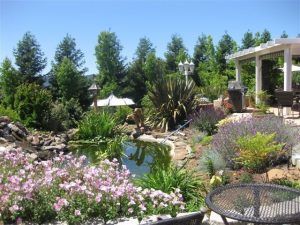Spring is here and glossy garden magazines are strutting their stuff. To gardeners, the pictures are like a candy store brimming with delicious color. But photographs can be misleading, colors enhanced, scenes cropped, and combinations staged. Paging through one magazine I found sun-loving Lamb’s Ears side by side with shade-demanding Coral Bells, and water-craving Bee Balm cheek-to-cheek with Lavender, a resident of drier soils.
Truth be told, most magazine photos are taken in areas with more rainfall and gentler sunshine than our sizzling summers afford. You may not be able to duplicate magazines’ stunning photos but plants suited to the Mother Lode can create wonderful combos with equally interesting textures and colors. Get design ideas from magazines, but get the nitty-gritty how-tos from knowledgeable local sources, based on the conditions in your own yard.
Here are some common Mother Lode gardening myths to watch for:
Plant ornamentals in the spring as the weather warms.
Spring is quickly followed by withering heat, especially in the warmer parts of the Mother Lode. It’s hard to hold off when nurseries showcase enticing specimens, but fall planting means more root growth before the heat of summer. More plants then survive in the long run—and that’s a good thing.
If you come across small plants in the spring that are just too good to resist, consider potting them up into larger containers and growing them on, in a protected spot out of the blazing sun, until planting time next fall. This works well when mail ordering small plants too.
As the weather warms, do plant warm weather annuals like zinnias, marigolds, and petunias, as well as summer vegetables.
Water daily for lush lawns.
Dig down with spade or trowel to check moisture level, then adjust lawn sprinklers so moisture penetrates to about eight inches. If the water runs off before it reaches this depth, try “pulsing” sprinkler time for a shorter period and repeating a few minutes later. Lawns need only half as much water in the spring and fall as they do in midsummer. If grass springs back when stepped on, you can delay watering.
A good garden is a bug free garden.
Actually, a healthy garden boasts a variety of wildlife from the soil up to the treetops, almost all depending directly or indirectly on insects. Given a chance, insects tend to keep themselves in check since they often compete for the same food and many are predators of each other and of other insects as well. Frogs, toads, lizards, bats and birds also require insects for food. All are shortchanged, even sickened, when we attempt to eliminate insects with toxic pesticides.
For help with troublesome insect control, first identify the insect then log on to https://ipm.ucanr.edu/ for management information. Or, contact Tuolumne County Master Gardeners (see contact information below).
For gardening success, always stick with the tried and true.
Master Gardeners often tell people to look around their neighborhood to see what grows well there. It is also important to learn about the microclimates in your yard—that warmer spot near the house for example, or the poorly drained area at the bottom of the yard.
However, as your skills grow, branch out; try a new flower or an unusual vegetable. You could become the talk of the neighborhood.
Suffering a chronic case of “zonal envy,” Master Gardener Vera Strader eagerly awaits the arrival of each new garden magazine and catalog.
Vera Strader is a University of California Cooperative Extension Honorary Master Gardener of Tuolumne County.

